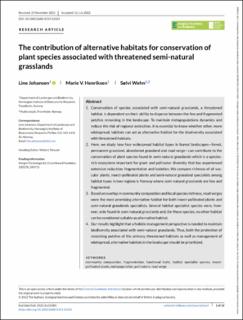| dc.contributor.author | Johansen, Line | |
| dc.contributor.author | Henriksen, Marie Vestergaard | |
| dc.contributor.author | Wehn, Sølvi | |
| dc.date.accessioned | 2022-10-31T13:37:09Z | |
| dc.date.available | 2022-10-31T13:37:09Z | |
| dc.date.created | 2022-10-24T14:08:16Z | |
| dc.date.issued | 2022-09-28 | |
| dc.identifier.citation | Ecological Solutions and Evidence. 2022, 3 (3), 1-12. | en_US |
| dc.identifier.issn | 2688-8319 | |
| dc.identifier.uri | https://hdl.handle.net/11250/3029166 | |
| dc.description.abstract | Conservation of species associated with semi-natural grasslands, a threatened habitat, is dependent on their ability to disperse between the few and fragmented patches remaining in the landscape. To maintain metapopulations dynamics and reduce the risk of regional extinction, it is essential to know whether other, more widespread, habitats can act as alternative habitat for the biodiversity associated with threatened habitats.
Here, we study how four widespread habitat types in boreal landscapes—forest, permanent grassland, abandoned grassland and road verge—can contribute to the conservation of plant species found in semi-natural grasslands which is a species-rich ecosystem important for plant and pollinator diversity that has experienced extensive reduction, fragmentation and isolation. We compare richness of all vascular plants, insect-pollinated plants and semi-natural grassland specialists among habitat types in two regions is Norway where semi-natural grasslands are few and fragmented.
Based on overlap in community composition and local species richness, road verges were the most promising alternative habitat for both insect-pollinated plants and semi-natural grasslands specialists. Several habitat specialist species were, however, only found in semi-natural grasslands and, for these species, no other habitat can be considered suitable as alternative habitat.
Our results highlight that a holistic management perspective is needed to maintain biodiversity associated with semi-natural grasslands. Thus, both the protection of remaining patches of the primary, threatened habitats as well as management of widespread, alternative habitats in the landscape should be prioritized. | en_US |
| dc.language.iso | eng | en_US |
| dc.publisher | John Wiley & Sons Ltd on behalf of British Ecological Society | en_US |
| dc.rights | Navngivelse 4.0 Internasjonal | * |
| dc.rights.uri | http://creativecommons.org/licenses/by/4.0/deed.no | * |
| dc.title | The contribution of alternative habitats for conservation of plant species associated with threatened semi-natural grasslands | en_US |
| dc.title.alternative | The contribution of alternative habitats for conservation of plant species associated with threatened semi-natural grasslands | en_US |
| dc.type | Peer reviewed | en_US |
| dc.type | Journal article | en_US |
| dc.description.version | publishedVersion | en_US |
| dc.rights.holder | © 2022 The Authors | en_US |
| dc.source.pagenumber | 1-12 | en_US |
| dc.source.volume | 3 | en_US |
| dc.source.journal | Ecological Solutions and Evidence | en_US |
| dc.source.issue | 3 | en_US |
| dc.identifier.doi | 10.1002/2688-8319.12183 | |
| dc.identifier.cristin | 2064486 | |
| dc.relation.project | Norges forskningsråd: 280715 | en_US |
| dc.relation.project | Norges forskningsråd: 230278 | en_US |
| dc.source.articlenumber | e12183 | en_US |
| cristin.ispublished | true | |
| cristin.fulltext | original | |
| cristin.fulltext | original | |
| cristin.qualitycode | 1 | |

